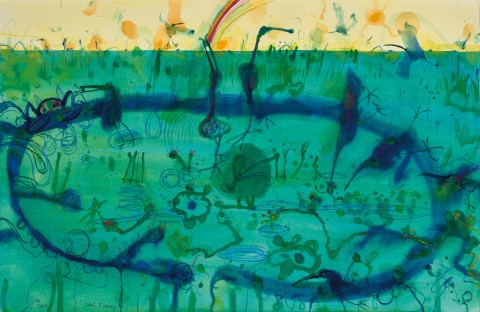TIDAL ESTUARY, 1993
JOHN OLSEN
watercolour and pastel on paper
97.0 x 152.0 cm (sight)
signed and inscribed with title lower left: John / Olsen / ‘Tidal Estuary’
Private collection
Leonard Joel, Melbourne, 23 August 1995, lot 38
Private collection, Melbourne
We are grateful to Kylie Norton, Editor, John Olsen Catalogue Raisonné, for her assistance with this catalogue entry.
‘…I brushed a line around the core theme, the seed-burst, the life-burst, the sea-harbour, the source of life… I wanted to show the Harbour as a movement, a sea suck, and the sound of the water as though I am part of the sea... I am in the sea-harbour and the sea-harbour is in me.’1
With his distinctive meandering line, exuberant mark-marking and mastery of colour, John Olsen is universally acclaimed among both critics and collectors alike as Australia’s most important contemporary artist. Throughout his vast career now spanning more than seven decades, he has revealed an unerring fascination with the natural world in all its myriad forms, creating evocative depictions of the landscape that arguably capture the spirit and character of this country more eloquently than any other non-indigenous artist before him. Significantly, despite his extensive travels throughout the Australian interior and further abroad in England, Spain and Portugal, it the beauty of the Sydney Harbour and its surrounds that has been his most enduring muse – inviting endless physical and intellectual wonderment both at the colour and play of light on the water, and the various life forms inhabiting the sea and its edges.
No doubt borne from an idyllic childhood spent living on the shores near Bondi, Olsen’s love of the harbour was reignited in the early 1960s when, having recently returned from abroad, he moved with his young family into a small fisherman’s cottage in the picturesque Watsons Bay at the tip of the South Head. Drawing inspiration anew from the colour, dynamism and vitality of the harbour, Sydney’s crown jewel, thus Olsen embarked upon his ‘littoral’ series of works which, featuring the chaotic flux of tides, city and people, are resplendent in their vivacious palette and energy. Witness for example, Entrance to the seaport of desire, 1964 or the celebrated Five Bells, 1963 (both in the collection of the Art Gallery of New South Wales) – the latter inspired by the tragic 1939 poem of the same name by Kenneth Slessor that would also provide the impetus for the artist’s monumental mural commission for the northern foyer of the Sydney Opera House, Salute to Five Bells, 1972 – 73.
An effervescent watercolour dating from his later years, Tidal Estuary, 1993 attests to Olsen’s ‘lifelong love affair with Sydney Harbour’2, bringing a freshness and immediacy to a subject that has sustained him for decades. Exuding lyricism and informed by a belief in the organic interconnectedness of all things, the work resonates with a vitalistic energy – betraying a sense of not only keen observation, but joyful celebration derived from a lifetime dedicated to physical and spiritual immersion in the landscape. In a manner akin to the artist’s earlier interpretations of the subject, dominating the composition here is a cell-like form in which tendrils of calligraphic line and brilliant colour coalesce, with the extraordinary range of mark-making of varying degrees of intensity and pace layered over a delicate background wash. Employing Olsen’s signature ‘all-at-once’, multi-perspective approach – ‘I’m down on the canvas one moment and up flying the next, or looking sideways or underneath’3 – thus the work possesses a remarkable expansiveness, stretching out towards the high horizon and pushing against the edges and corners of the frame. Map-like, the aerial view details the sensuous lines of the estuary and peregrinations of its various marine creatures, yet as the eye ascends upwards through the picture plane, it is brought back to reality by the illusion of depth suggested in the conventional horizon line and flat field of golden sky beyond.
A superb example of Olsen’s talent as a ‘master watercolourist’, indeed Tidal Estuary not only tangibly embodies the sight as well as the feel of this iconic watery microcosm, affectionately described by Olsen as the ‘umbilical chord [sic.]’4 of the city. More broadly perhaps, it illuminates the artist’s enduring interest in the artistic parallels between the structures of such biomes and the relationships that connect them; as he reflects, ‘When one begins to see nature as a series of processes, the appearance of the object change – form follows function… I would like to make the viewer see the microcosm and the next moment the expansiveness of the universe’.5
1. The artist, referring to his celebrated Five Bells, 1963 in the collection of the Art Gallery of New South Wales, see: https://www.artgallery.nsw.gov.au/collection/artists/olsen-john/
2. Bungey, D., John Olsen: An Artist’s Life, Harper Collins, Sydney, 2014, p. 110
3. The artist, cited in Hawley, J., ’John Olsen’, Encounters with Australian Artists, University of Queensland Press, Queensland, 1993, p. 129
4. Olsen’s deliberate misspelling reinforcing the qualities of harmony and unity – see Murphy, J., ‘The Journals of John Olsen’ in Hurlston, D., and Edwards, D. (eds.), John Olsen The You Beaut Country, National Gallery of Victoria, Melbourne, 2016, p. 98
5. The artist, cited in John Olsen, My Complete Graphics 1957 – 1979, Gryphon Books, Sydney, 1980, p. 132
VERONICA ANGELATOS
